There’s something about needlework accessories… something that compels us to buy them, use them, enjoy them.
When I first started embroidering as a kid, accessories were never part of the package. I didn’t even have real scissors at first. I remember biting my thread to cut it!
But as an adult, I’ve found that needlework accessories and specialty tools are part and parcel of my whole love affair with embroidery. However, I’m not prone to “collecting” them just for the sake of having them. They have to be useful. And if they’re attractive to boot – well, that’s just the best type of accessory, in my mind!
Today, I’d like to show you a new accessory on the market – one that I believe is useful, unique, and attractive. I love these little needle tins!
While we look at them, we’ll chat with Lamora Haidar of Access Commodities, who conceived the idea for the needle tins and had them made for distribution. We’ll learn a little bit about the whole needlework accessory market, how ideas come about and progress to a finished product, and glean a little insight to this love of accessories to which many embroiderers are prone.
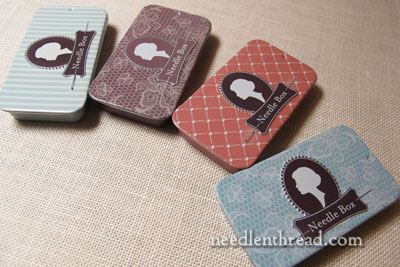
These are the needle tins. They are small, tin boxes with sliding lids, that come in sets of four. They’re the first bulk-needle-storage solution I’ve seen that’s actually attractive. Those clear plastic needle tubes don’t hold a candle to these lovely little things!
I love the tins – not only are they are a perfect solution for storing bulk needles, but also for storing small collections of needles for specific projects. They’re a cross between beautiful, elegant, darling, and practically edible.
Here’s my interview with Lamora:
MC: Why do you think needlework accessories are so important to the needleworker today?
Lamora: Embroiderer’s lives in the 19th century were more centered around the home, and in their daily lives, people did not venture that far away. Our lives in contrast are much more mobile and some of us don’t just stitch at home. Some of us take our embroidery everywhere we go. We are conditioned to seek out convenience and improvement in our pastimes. And, besides, who doesn’t like pretty things in their workbox?
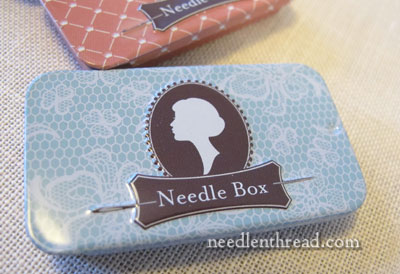
MC: What’s your favorite needlework accessory and why?
Lamora: Hands down, a quality thread and the appropriate needle suited to the type of embroidery. For me, it is a simple luxury to embroider with a good needle and beautiful thread making every stitch a pleasure.
MC: What do you look for in a needlework accessory?
Lamora: Ease of use, quality craftsmanship, and does it serve the purpose? I also believe a needlework accessory should be artfully designed which in turn enhances the delight for the user.
MC: Can you tell us a bit about the journey from vision to reality when you conceive an idea for a needlework accessory?
Lamora: You are right – it definitely is a journey. Wish I could tell you it moves in a straight line, but most of the time it does not. When creating products, my design team starts with an idea centered around a purpose. In this case, what to put your needles in if you buy them in bulk or need to put them in something besides a pincushion or a needlebook? We start by seeking good materials, and craftspeople / manufacturers that are reliable to produce it. Once the product is made, we have to consider packaging design and the retail environment where the product is going to be sold. The challenge is how to take a smartly designed product and maintain how attractive it appears inside a package.
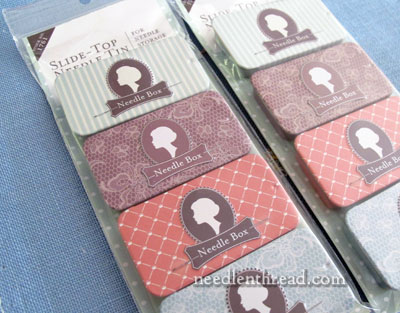
MC: What prompted you to come up with the idea for little needle tins?
Lamora: We had this idea 7 years ago when we started working on a workbox for embroiderers. We realized that while there were a lot of things on the market, no one was addressing the other essential accessories an embroiderer would use besides a needles and thread. Accoutrements, our line of different kinds of pins, good quality twill tape, and Turkish emery among other things was born to serve this need. A diminutive box for needles was something we came up with, as we loved the wonderful Victorian brass ones. Finding a manufacturer to work to that level of artistry was not an option. As time has passed, we kept circling back to this as an idea and how we could make something for today’s embroiderers.
MC: Why this particular design for the needle tins?
Lamora: My daughter Justine lives in NYC and works in digital media. She is a twenty-something, and like other young women her age she is interested in fashion and design history. We talk a lot about product and package design, and what is alluring. I asked her to design these for me. The design brief was simple. I wanted something a little girly, but not too much. While we could have imitated the Victorian period brass needlecase designs, we reached a little further back for design inspiration to the Regency period (1795-1830) – hence, the silhouettes. Is this the point at which I confess to being addicted to all things Jane Austen?
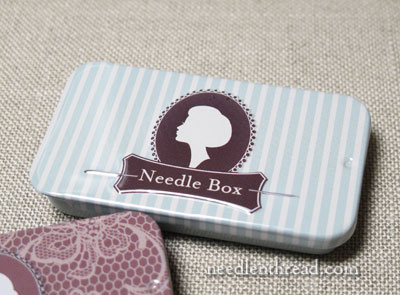
MC: I know people will ask, so let’s discuss the lack of magnets in the tins. Lately, it seems magnets are center stage in just about every needle storage solution on the market. Why did you forego magnets in the tins?
Lamora: We did try magnets with the production samples we got and rejected the idea for several reasons. First we found that the needle tins stuck to other things in our workbox. And, with magnets the needle tins themselves stuck to each other. Personally, I don’t like my needles magnetized. However, if the purchaser wants to put a magnet in they can certainly do so.
MC: What do you like best about the needle tins?
Lamora: I just love the embossing of the silhouettes and needles on the face of the lid, and the quality of the tin. We worked very hard to find a manufacturer that produced one that felt good in your hand, and not flimsy. I knew these would be a success when they were produced and my daughter showed them to her friends and they asked where they could find them. I think with this price point they are the perfect gift for fellow embroiderers.
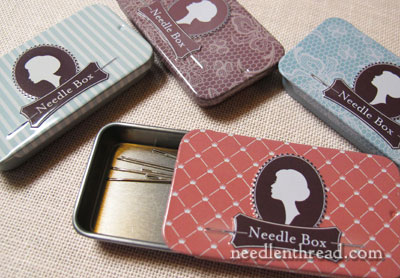
Thanks, Lamora!
Yep, I love these new little needle tins! And I love the fact that they come in a package of four. They work well as a set, to store different types of needles in each tin. Or you can break up the set and use them as little token gifts.
And here’s a thought: A vintage-type label affixed to the base would be a perfect way to record the type and size of needle stored within, if you use them for bulk storage. For example, these glitter jar labels available as a free download from Just Something I Made might work really well – the small round ones or some of the oblong and rectangular designs would do the trick. If they print too large as designed, you can rescale them in your printer settings. I’m going to give them a try!
Where to Find Needle Tins
You can find Needle Tins through any fine needlework shop that carries goods from Access Commodities. If your favorite needlework shop (locally owned) doesn’t carry them, ask! They can always be special ordered!







These are absolutely cute and would be ever so handy to have – I’m thinking how perfect they would be to hold little things (not only needles) in my hussif.
Now, when they begin making the tins (and other needle storage options) in the same colors as the pony, colored eye needles, people who prefer needle tins (and the other options) will be all set! 🙂 Personally, I don’t have space in my grab and go/ general storage for a bunch of tins, so I will stick with the brass tube I am using. As far as the ones I have stored, since they are “hiding” in my treadle drawer, attractive is not needed, so they can stay in the tiny (needle sized), corked glass bottles they are (upside down on top of a bit of foam) in. I do use repurposed tins in my storage box, but for other things besides needles.
Hi, my name is Ezia, I am a cross stitch designer, my company name is “New York Dreamer Needleworks”. I really love your work!
I have a question for you, I hope you can help me. I’ m looking to make cut work pattern ( I love cut work) and I was wandering how to make it.. Is there a program I can use? Or do it by hand? Thank you for your time!!!
Ezia
Hi, Ezia – I think drawing them by hand is the best bet, and then scanning them and turning them into vector files would be good, if you want to print them… MC
These are lovely. I too would want to label them somehow with needle sizes, even needle types. And one could be for those delicate little needle threaders. Or perhaps a tin for some sparkly beads. Guess I’m getting carried away here but they would stack nicely too.
I agree: I would avoid the magnets in there. Many people now work from a computer pattern and to have a magnet that close to a laptop is asking for trouble.
Hi mary,
Love hearing about the design process. In case anyone else is interested I am taking an online class from Penn State University called “Design, creation of artifacts in society” which is fantastic and FREE through the Cousera program which has made classes from top universities around the world free. You can fully partake in these classes or just “watch”. The tins are adorable,thanks for sharing, k
Many of us have been using altoid tins and such for years – without the ‘specialty’ cost.
The slide out feature looks great but that graphic is disgustingly old fashioned and denigrating.
Don’t quite get what you’re trying to say? Denigrate means to defame the reputation of, or to belittle. Do you mean that, because the designs have an old-fashioned flavor to them and they have a silhouette of a woman on them, they are therefore belittling to women? Or are you saying they defame the reputation of women somehow? I’m not quite sure I follow the “logic” in either case…
They may not be to everyone’s taste, but I like them, and that’s why I wrote about them.
I have also been using repurposed metal mint tins for years(already posted), and used plastic tic-tac boxes as a teenager. Like Mary, I do not understand what is denigrating about a cameo design. Old-fashioned, absolutely, to some people, since beauty is in the eye of the beholder, but denigrating? Not in my opinion. Cameos have been made by humans for millennia, and were not just human heads, many had designs that were religious or mythological in nature, sometimes even done on seashells. Cameo describes the carving style, the human head cameo carved jewelry was called that because the carving style existed first. I believe originally cameos were done as rings or seals to “sign your name with, etc” and later on more decorative things began to pop up. That is likely when putting “pictures” on cameos as opposed to writing began, because most people were illiterate prior to the last century or so. When I think about it, coins (which have existed since ancient Greece) are a type of modified (poured into molds rather than carved) double sided cameo, and most coins ever made, modern or otherwise, have just about anything and everything on them, not just human heads. The Ohio US quarter has the Wright Flyer on the reverse, and I do not consider that to be denigrating to pilots. To be honest, those tins might be more appealing to me if they did come with the Wright flyer on them, but then again, that is just my preference. Just because Regency and Victorian women wore their grannies on a brooch or necklace does not belittle women in my opinion, especially since women today can buy sport pants with obnoxious comments printed across their backsides if they like. If the cameo pattern makes too many stitchers uncomfortable, I am sure Lamora will get her daughter to work out another pattern, or lose a lot of business. In the mean time, those of us (including me) who are happy with our repurposed mint tins are entitled to our opinions, but can agree to disagree when posting on someone elses blog.
I’d be leary until I could see them in use for a couple of years…how many old needle tins have we all seen that were full of damaged needles from the rust/moisture/other issues, the needles within spotted and unusable? Part of the issue seems to be the finish on the metal (or lack thereof, sometimes) but I’ve not fooled around to actually see what works and what doesn’t; I just don’t store needles in metal at all. I much prefer some small glass tube/bottle of some sort; many of the old ones are colored glass, making them pretty as well. And as a previous poster commented, cork is the ideal closure.
As to labels, I like that one; flourishes are a favorite design element of mine. Another source for many label designs for free is at this blog: http://blog.worldlabel.com/2013/printable-oval-labels-free-template-set.html. The blogger there is a supplier of the labels themselves (not for free, for sure!) but often has label designs to d/l for free, some have been quite unique and very attractive.
I must say that way my first reaction. We live in a slightly humid climate and I have had lots of things including needles rust, so the idea of storing needles in a tin seems counter-intuitive to me. However, since I am looking for a different storage method for my needles and I have a large store of silica gel, I may just have to try these. I think they are very cute, despite the reaction earlier, not denigrating to anyone (except maybe me, since I still wear my double cameo brooch which must make me unacceptably old-fashioned).
At the moment I am using a needle book which I made with felt for the ‘pages’, but I lose track of which size needle belongs where, as I have several in use at one time. I am finding that the needles are even rusting in the felt which I thought was wool but probably isn’t.
What I really need is something better than a printed guide to needle sizes, since even the same size needles vary from maker to maker. Help!
Thanks to Mary and Lamora for sharing this. I love hearing about new gizmos.
Christina F: I did not mean to imply that being old-fashioned was bad. You are 100% entitled to be old fashioned if you like. I also do not believe cameos are “unacceptably” old fashioned, just a smidge. 🙂 Unless of course someone is also binding their daughters feet (china before 1900-ish) or sending their 7 year old sons away to begin military (Classical Sparta 650-150BC-ish I think) training, some 17 year olds could use a little of that, but 7 year olds just need a box of crayons and some celery and peanut butter.
Christina. You asked for help with your needle book. How about embroidering size numbers on shapes (like hearts as an example) that match your needle book, and then appliqueing them to the pages? Just an idea.
These are really cute little tins! They remind me of tiny candy boxes! I agree – they are multi-purpose if you don’t need them for your needles. Hooks & Eyes, even my cache of asirin fit nicely! More confections for my sweet bag!!
Thank you Mary, I will give a shot!!!
Ezia.
Dear Mary
I’m late today been sorting out finances ahh!!!. Anyway I love those tins, Jane Austin style a women after my own heart, love the theme of the Regency period as this is one of my favourite periods in history. A great idea to store needles I’m always loosing mine and a great idea to be able to slide open the tins and I love the glitter jar labels the combination would look lovely and reasonable priced. Thanks Lamora for a lovely design and Thanks Mary for another interesting article.
Regards Anita Simmance
I will have to snatch up these next time I’m at Nordic Needle. Thank you for sharing about them!
I learned to use Altoids tins for small buttons,pins, and sewing needles from my mom. This seems like a natural choice to me.
I would love to purchase the coloured pony needles Mary but I’ve searched on-line and can’t find a supplier here down-under, or anywhere else..
Also, those delightful cameo tins are so enticing. I’m collecting flower seeds from my late autumn garden and they look just the right size to store them in until next spring. And what a lovely present they’d make.
I tend to keep unused needles in their original packaging for two reasons – a – they are labelled and b I can find them again! So the little tins really do need the labels. But being mean I have just realised I have a collection of similar tins. The National Trust use them for the little mints, with a lovely range of flowers on top. Never thrown away because they are too pretty. Now I know what to do with them. So I am afraid recycling wins – but it is a good idea.
Where are these tins manufactured, please?
Thank you.
Hi, Kathleen – I think they are made in the US, but I will double check that. MC
These remind me of Just Nan’s needle slides. The major difference seems to be size and cost, although I guess you could also throw in style. From pictures it seems that Just Nan’s might be a little longer. If you were looking purely at price. Access Commodities is the hands down winner at 4 for $11 versus Just Nan’s $7 each price. If style was a major concern, Just Nan’s are very colorful and fairly trendy, while Access Commodities do have a vintage appeal. I buy needles in bulk all the time. I work on very large projects and usually have more than one project going at a time. If I am working on a design with multiple color changes, I keep each color threaded. With all of that said, I store my bulk needles on a strip of wool felt rolled up with the needle size Sharpie’d on the outside and stored in a clear jar that used to be a candle container. I do use tins, but usually as small storage for project bags. The size and price of the Access Commodities tins are definitely an appeal.
Now here is something I certainly can use. I am always needing a place for my extra needles. What an excellent idea. I would love to win a set of these.
These little needle cases soound perfect for organizing my hand embrodery & sewing room! So neat!
These look awesome and they would REALLY come in handy when I am going to the stitch in at my LNS. My most FAVORITE needlework in counted cross stitch. Just can’t get in enough stitches. I think these are great tins because with them being magnetized you don’t have to worry about accidentally knocking them all over the place like I often do!